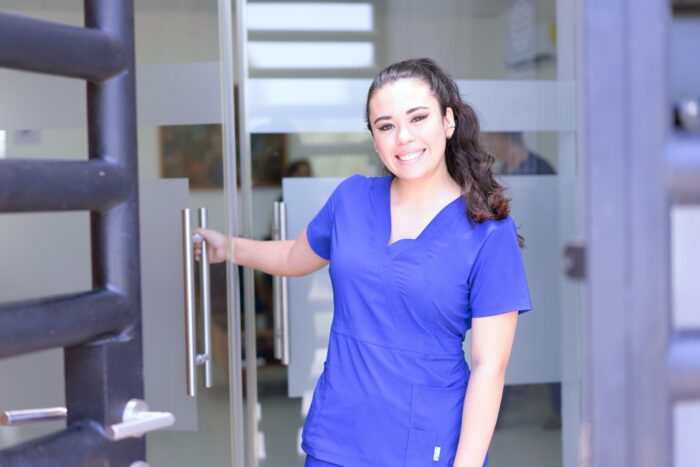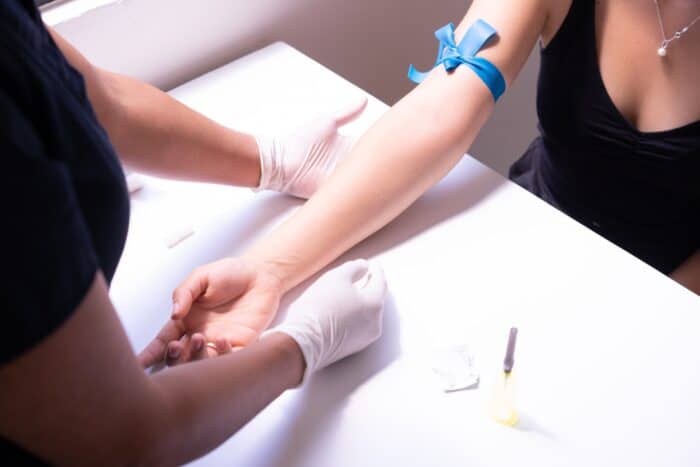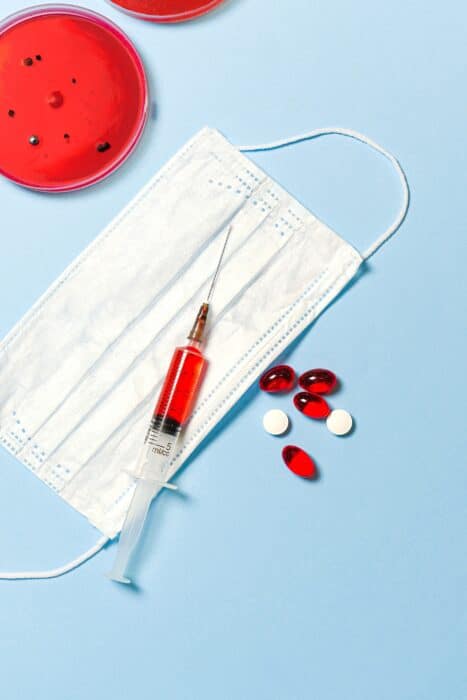A career in medical assistance might be the best fit for you if you wish to enter the healthcare industry without many educational requirements.
A Medical Assistant is a healthcare worker who provides support services to physicians, nurses, and other healthcare professionals. Their duties generally include both clinical and administrative tasks, which can range from assisting physicians with bedside procedures to scheduling appointments.
There are many additional duties of a medical assistant, and you might be wondering if a medical assistant can draw blood.
Usually, medical assistants are allowed to extract blood while being supervised by a licensed doctor. However, certain states mandate that medical assistants possess a phlebotomy certification to perform blood draws.
These states consist of California, Louisiana, Nevada, and Washington.
Read further to know all the necessary information regarding medical assistants’ involvement in blood drawing, including obtaining a phlebotomy certification and additional details.
Also see: Is Medical Assistant a Good Career?
Which States Allow Medical Assistants to Draw Blood?
The scope of practice laws for medical assistants define the specific responsibilities and tasks that a healthcare professional is legally authorized to undertake.
These laws vary from state to state, as each state establishes its regulations regarding the scope of practice for medical assistants.
Also read: Medical Assistant Scope of Practice by State
There are only four states that restrict medical assistants from performing phlebotomy or drawing blood.
Let us take a look:
- California-
In the state of California, medical assistants are permitted to perform blood draws only if they have fulfilled the training prerequisites established by the state. The requirement involves the completion of a minimum of 10 hours of venipuncture training.
- Washington-
In Washington, medical assistants are required to obtain a credential from the Washington State Department of Health to practice in their field. To perform blood draws, medical assistants must apply for a phlebotomy certification, which necessitates the successful completion of a phlebotomy training program.
Also see: Medical Assistant Program
- Nevada-
In Nevada, medical assistants are required to possess a phlebotomy certification to perform blood draws.
- Louisiana-
To conduct blood draws in Louisiana, medical assistants are required to possess a phlebotomy certification. This means that they must obtain the necessary certification specifically for phlebotomy to perform this task.
Apart from the above-mentioned states, all other states across the U.S. have no restrictions for medical assistants drawing blood.
Read: 12 Reasons to Become a Medical Assistant
Why Do Medical Assistants Draw Blood?
Blood plays an important role in assessing one’s health as it serves as a carrier for essential nutrients, hormones, oxygen, and other vital substances throughout the body.
Medical assistants play an essential role in drawing blood, assisting other healthcare providers in monitoring patients’ well-being, and diagnosing various medical conditions.
The blood samples collected by medical assistants are usually sent to a clinical laboratory, where they undergo analysis and examination utilizing advanced medical instruments.
There are several reasons why drawing blood may be necessary.
Let us take a look at a few examples:
- Obtaining a complete blood cell count: This helps assess the overall health of a patient by examining the different types of blood cells, including red blood cells, white blood cells, and platelets.
- Testing for minerals: Blood tests can be used to measure the levels of various minerals in the body, such as iron, potassium, calcium, and others. This information is valuable in diagnosing deficiencies or imbalances.
- Assessing blood glucose levels: Monitoring blood glucose levels is crucial for individuals with diabetes or other conditions affecting blood sugar regulation. Regular blood tests can provide insights into how well the body is managing glucose levels.
- Monitoring hormone levels: Blood samples are often used to measure hormone levels in the body. This can include hormones like testosterone, cortisol, thyroid hormones, and more. Monitoring these levels helps diagnose hormonal disorders and evaluate treatment effectiveness.
- Monitoring enzyme levels: Enzymes, such as alanine aminotransferase (ALT), can indicate liver or muscle damage when their levels are abnormal. Regular monitoring of enzyme levels helps assess organ function and diagnose related conditions.
- Detecting infectious organisms: Blood tests can identify the presence of infectious agents such as bacteria, viruses, or parasites. This is crucial in diagnosing and treating infections.
- Assessing blood clotting ability: Blood tests can evaluate how well the blood clots are, which is important for assessing bleeding disorders or the effectiveness of certain medications.
- Determining blood type: Blood typing is essential for blood transfusions and ensuring compatibility between donor and recipient blood types.
- Blood donation: Drawing blood is necessary during the process of blood donation, which helps meet the demand for blood transfusions and saves lives.
Do Medical Assistant Training Programs Include Phlebotomy Training?
Phlebotomy is known as the skill of extracting blood from veins using a puncturing tool. Blood draws are widely performed in medical settings as they provide valuable diagnostic information. Additionally, medical assistants must receive proper training in phlebotomy.
Read: Accelerated Medical Assistant Program
While most states do not require a specific phlebotomy license to perform blood draws, many employers prefer candidates with a phlebotomy certification, especially if the role of medical assistant includes blood drawing responsibilities.
Holding a certification in phlebotomy can enhance job prospects and demonstrate proficiency in this specialized skill set.
Also see: Medical Assistant Skills

Do You Want To Become a Medical Assistant? Check Out Free Medical Assistant Masterclass!
In our masterclass you learn:
- How to be a medical assistant faster…in just 4 months!
- Avoid student debt & driving to classes
- #1 thing employers want from Medical Assistants
- How to stand-apart & get a university certificate for a strong resume
How to Get Your Phlebotomy Certification?
If you are interested in obtaining your phlebotomy certification, the process is relatively easy, though it may vary slightly depending on the state you intend to work in.
Read more: Where Can Medical Assistants Work?
Here are the general steps to acquire your phlebotomy certification:
- Complete an approved phlebotomy training program: Enroll in a recognized phlebotomy program, available through community colleges, trade schools, online platforms, and other educational institutions. These programs typically span from a few weeks to several months.
Also see: Medical Assistant Educational Requirements
- Pass a certification exam: Various organizations, including the American Society for Clinical Pathology (ASCP) and the National Phlebotomy Association (NPA), offer phlebotomy certification exams.
See: Medical Assistant Certificate Requirements
- Refer to your state’s Department of Health website: It is important to consult the website of your state’s Department of Health to check for any additional requirements, such as obtaining a license. Each state may have specific regulations, and their website will provide you with the necessary information and steps to follow.
Also see: Medical Assistant License
Also see: How to Become a Medical Assistant
What If You Don’t Want to Draw Blood as a Medical Assistant?
If you are wondering whether you can still work as a medical assistant if you do not wish to perform phlebotomy, yes, it is possible to work as a medical assistant without the requirement of performing blood draws.
The role of a medical assistant encompasses a wide range of tasks, allowing for opportunities that do not involve drawing blood.
When seeking medical assistant positions, it is essential to carefully review the job description to determine if blood draws are expected as part of the responsibilities.
Some medical assistants also choose to concentrate mainly on administrative duties rather than clinical tasks. These positions are often referred to as medical administrative assistants.
Typically stationed at the front desk of a medical office, their responsibilities entail scheduling appointments, handling phone calls, managing medical billing, and maintaining inventory levels.
Read: CMAA vs CCMA
Medical Assistant Specialities Likely & Unlikely to Draw Blood
There are many types of medical assistants, and each specialty comes with its nature and scope. Some of these medical assistant specialties are more likely to draw blood than others, and if you are not interested in drawing blood, this can help you avoid going for such specialized careers.
There are several medical assistant specialties in which drawing blood is likely to be a requirement.
Here are a few examples:
- Endocrinology: In the field of endocrinology, which focuses on hormonal dysfunction, blood plays a vital role in diagnosing and managing conditions.
- Primary Care: Primary care physicians frequently order blood tests as part of routine check-ups or wellness exams to evaluate a patient’s overall health. Medical assistants working in primary care settings may be responsible for drawing blood to facilitate these tests.
- Pathology: Pathology involves diagnosing diseases by utilizing tools such as microscopes and assays. Many diagnostic tests in pathology rely on analyzing blood samples for signs of disease. Medical assistants may be called upon to draw blood samples to assist in these diagnostic processes.
Now, let us also see some examples of medical assistant specialties wherein you are unlikely to draw blood as a medical assistant:
- Ophthalmology/Optometry: These specialties focus on treating and diagnosing eye disorders. Although certain systemic diseases can manifest in the eyes, it is unlikely for medical assistants in ophthalmology/optometry to perform blood draws as part of their duties.
Also see: Medical Assistant Job Duties
- Dentistry: Dental professionals specialize in treating oral health issues and performing dental surgeries. Blood draws are not typically performed in a dental office, so medical assistants working in dentistry are unlikely to be involved in drawing blood.
- Psychiatry: Psychiatry deals with the diagnosis and treatment of mental disorders. Medical assistants working in psychiatric settings are not typically expected to perform blood draws as part of their responsibilities.
Also read: How Long Does It Take to Become a Medical Assistant?
Conclusion
In conclusion, yes, many medical assistants are trained to draw blood as part of their versatile skill set. While the specifics can vary by state and employer, numerous medical assistants receive training and certification that allows them to perform this important task. Their ability to draw blood efficiently and safely adds to their valuable contributions in healthcare settings, supporting various medical procedures and ensuring patients receive quality care.
Related Resources:
- CMA vs CNA
- Medical Assistant Interview Questions
- Medical Assistant vs Medical Billing and Coding
- Is Medical Assistant Degree Required?
- Medical Assistant On-the-Job Training
- Medical Assistant Degree vs Certificate
- National Certified Medical Assistant NCMA
- Certified Medical Assistant
- Medical Assistant Degree Online 6 Weeks
- 4 Week Medical Assistant Program
Related Articles
-
How to Be Successful in College in 2022 – 7 Simple Tips to Succeed
-
How Do Scholarships Work? Read This First…Truth is Shocking
-
7 Best College Majors 2024: What Should I Major In?
-
How to Choose a College – 10 Things You Must Consider in 2024
-
Why Go to College? Top 13 Benefits for Adult Students in 2022
-
Top 5 Best Alternatives to Community College for 2024









